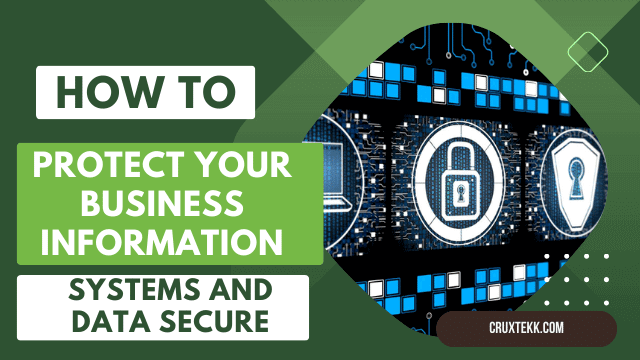Protecting your business information systems and data is crucial in today’s digital landscape, where cyber threats are constantly evolving. A breach can lead to data loss, financial losses, damage to your reputation, and legal consequences. Here are essential steps to help you secure your business information systems and data:
1. Conduct a Security Assessment
Start by assessing your current security posture. Identify potential vulnerabilities and risks within your information systems and data. This assessment can include a review of your hardware, software, network infrastructure, and policies.
2. Develop a Security Policy
Create a comprehensive security policy that outlines your organization’s security objectives, expectations, and procedures. Ensure that all employees are aware of the policy and understand their roles and responsibilities in maintaining security.
3. Control Access
Implement strict access controls to ensure that only authorized individuals can access sensitive data and information systems. This includes strong password policies, multi-factor authentication (MFA), and role-based access control.
4. Educate and Train Employees
Provide security training and awareness programs for all employees. Teach them how to identify phishing emails, social engineering attempts, and best practices for handling sensitive data.
5. Regularly Update Software and Systems
Keep all software, operating systems, and hardware up to date with the latest security patches and updates. Cybercriminals often exploit known vulnerabilities in outdated software.
6. Use Antivirus and Antimalware Solutions
Install and regularly update reputable antivirus and antimalware software on all devices within your network to detect and remove threats.
7. Implement Encryption
Encrypt sensitive data both at rest and in transit. This adds an extra layer of security, making it much more challenging for unauthorized individuals to access or understand the data.
8. Backup Your Data
Regularly back up your business-critical data to secure, off-site locations. This helps you recover your data in case of ransomware attacks, data corruption, or other disasters.
9. Monitor Network Traffic
Use network monitoring tools to keep an eye on network traffic for suspicious activity. Intrusion detection and prevention systems (IDS/IPS) can help identify and stop threats in real-time.
10. Set Up a Firewall
Configure firewalls to control incoming and outgoing network traffic. A firewall acts as a barrier between your network and potential threats from the internet.
11. Secure Mobile Devices
Establish a mobile device management (MDM) policy to ensure that all mobile devices accessing your business data adhere to security standards, including encryption and remote data wiping.
12. Plan for Incident Response
Create a detailed incident response plan that outlines how your organization will respond to security incidents. This plan should include steps for containment, eradication, recovery, and reporting.
13. Implement a VPN
Use virtual private networks (VPNs) to secure remote access to your network. A VPN encrypts data as it travels over the internet, making it secure even when employees are working from outside the office.
14. Conduct Security Audits
Regularly perform security audits and vulnerability assessments to identify and address weaknesses in your systems and procedures.
15. Secure Physical Access
Restrict physical access to data centers and server rooms. Implement measures like access cards, biometrics, and surveillance to prevent unauthorized entry.
16. Consider Cybersecurity Insurance
Evaluate whether cybersecurity insurance makes sense for your organization. It can help mitigate the financial impact of a breach.
17. Stay Informed
Stay informed about the latest cybersecurity threats and trends. Subscribe to threat intelligence services and keep up with industry news to adapt to emerging threats.
Remember that cybersecurity is an ongoing process. Threats evolve, so your security measures should evolve with them. Regularly reassess your security measures, update your policies, and educate your employees to maintain a strong defense against cyber threats.
Here are some frequently asked questions (FAQs) related to protecting your business information systems and data security:
1. What are the key elements of a strong cybersecurity strategy for my business?
A strong cybersecurity strategy includes elements like access controls, regular updates and patch management, employee training, data encryption, incident response planning, and monitoring network traffic.
2. What is the role of employee training in cybersecurity?
Employee training is critical as employees are often the first line of defense. Training helps them recognize and respond to potential threats, such as phishing emails and social engineering attacks.
3. Should I invest in cybersecurity insurance for my business?
Cybersecurity insurance can be valuable, especially if you handle sensitive customer data or have an online presence. It can help cover financial losses in the event of a data breach or cyberattack.
4. How can I protect my business against ransomware attacks?
Protecting against ransomware involves regularly backing up data, keeping software updated, using reliable antivirus software, and educating employees about the dangers of opening suspicious attachments or links.
5. What is the best way to secure remote workers’ devices and data?
Securing remote workers’ devices includes using virtual private networks (VPNs), strong authentication methods, and mobile device management (MDM) solutions. Encrypting data on these devices is also essential.
6. How often should I conduct security assessments and audits for my business?
Regular security assessments and audits should be conducted, with the frequency depending on your organization’s risk profile. For many businesses, annual assessments are a good starting point.
7. What should I do in case of a security breach or cyber incident?
In the event of a security breach, you should follow your incident response plan, which includes containing the incident, identifying the cause, mitigating the damage, and notifying relevant stakeholders and authorities.
8. Can small businesses be targeted by cyberattacks?
Yes, small businesses are often targeted by cybercriminals. They may be seen as easier targets due to potentially weaker security measures. It’s crucial for all businesses to prioritize cybersecurity.
9. What are the benefits of data encryption for business data?
Data encryption protects sensitive information from unauthorized access. Even if a breach occurs, encrypted data is difficult for attackers to read, reducing the risk of data exposure.
10. Are there government regulations or compliance standards that I need to follow for data security?
Depending on your industry and location, there may be specific data security regulations and compliance standards to adhere to. Examples include GDPR (for European businesses) and HIPAA (for healthcare organizations).
Remember that cybersecurity is an ongoing process, and staying informed about the latest threats and best practices is crucial to protecting your business information systems and data.


